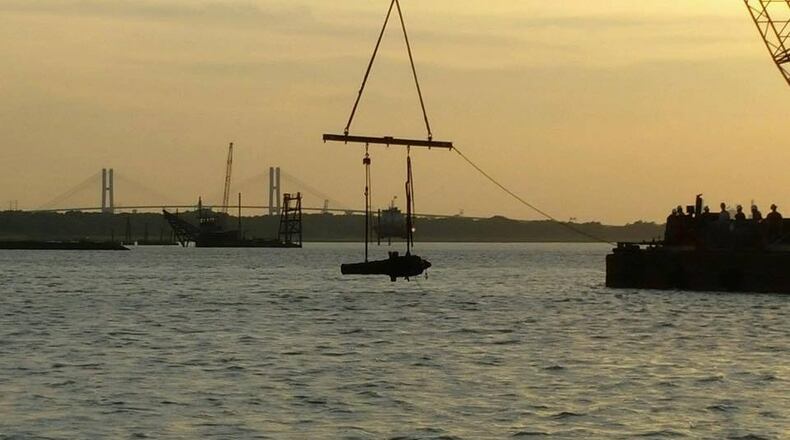Sometimes, making way for the future brings up the past.
In January, just as the U.S. Corps of Engineers Savannah District was wrapping up the 22 year-long Savannah Harbor Expansion Project (SHEP) that dredged the Savannah River from 42 to 47 feet to accommodate larger vessels and increase port revenue, archaeologists made an astonishing find: Twelve Revolutionary War-era cannons that had been resting in the muddy depths for almost 250 years.
“It was a surprise since this was an area that had been dredged before,” said Corps archaeologist Andrea Farmer. “But this is a very dynamic river. It’s just littered with historic material.”
The dozen rusted, barnacle-encrusted guns join three others of similar size found a year before, along with fragments of anchors and ammunition in a deep spot known as Five Fathom Hole in front of Old Fort Jackson, not far from where the Civil War-era ironclad CSS Georgia was recovered in 2015.
Credit: Paul Hankins, Donjon Marine Services
Credit: Paul Hankins, Donjon Marine Services
After the first cannons were discovered during preliminary dredging meant to identify any unexploded munitions buried in the mud, the Corps called the Commonwealth Heritage Group, the same team that excavated the CSS Georgia.
All SHEP dredging ceased as Commonwealth’s marine archaeologists used sonar to collect data by crisscrossing the bottom of the river, a process called “mowing the lawn” that pinpointed 12 more cannon-shaped objects. Then came the complicated, dangerous procedure of getting them out of the water.
A video released by the Corps shows divers from Savannah-based Commercial Dive and Marine Services sifting through murky waters, connected by cables to an oxygen source on the small boat above as they looped sturdy straps and inflatable bags to maneuver each cannon out of the mud. Adding to the complexity were the river's whipping current and the dozens of massive ships coming in and out of the harbor.
“With these strong tides, things get pushed around — including divers,” Commonwealth principal investigator Will Wilson described to a crowd gathered at the Savannah History Museum in February.
In addition to having to schedule around slack tides for safest conditions, added Wilson, “we had maybe one hour a day to align with the freighter traffic.”
Credit: Michael Jordan, Cosmos Mariner Productions
Credit: Michael Jordan, Cosmos Mariner Productions
All 15 cannons are now under the auspices of the Corps, where they are undergoing stabilization procedures to conserve them for future display.
“Surprisingly, most of them are in good shape,” says Farmer.
Where are the cannons from?
The discovery brings light to Savannah's role in the Revolutionary War, which is often overshadowed by its Civil War history. The cannons are believed to have been sunk in September 1779, when British commanders who controlled the city frantically scuttled several ships to block the entrance to the harbor from the French naval fleet led by American ally Charles Hector, comte d’Estaing.
“The French got here faster than anyone was expecting,” explains Dr. Christopher Hendricks, an expert in Revolutionary America at Georgia Southern University’s Armstrong campus. “They caught the British completely off guard.”
In preparation for a French assault from the water, the British had already blocked the channel with two frigate ships, the HMS Foley and the HMS Rose. It is from the latter — famous for her role in earlier battles against American revolutionaries in New York — that archaeologists first thought the recently excavated cannon originally came.
However, records show that all artillery was removed from the HMS Rose before it was sunk further upstream.
Credit: Richard Burkhart/Savannah Morning News
Credit: Richard Burkhart/Savannah Morning News
As the squadron of 25 ships stocked with 4,000 French, Irish and Haitian troops positioned at the mouth of the river, the British ramped up their defense by sacrificing two more vessels, the armed merchant ships Savannah and Venus, which had exchanged fire with the French earlier in the month.
It is to one or both of these ships that archaeologists now believe the cannons once belonged.
“I’d like to assume they’re all from the Savannah, but we don’t know for a fact,” said Commonwealth Maritime Director Stephen James. “There’s no evidence of [the rest of] the vessel down there.”
Credit: Graphic courtesy of Panamerican Consultants, Inc.
Credit: Graphic courtesy of Panamerican Consultants, Inc.
In any case, scuttling the Savannah and Venus worked for the British. The tactic kept the French bombardment away from the city's batteries, provoking d'Estaing to launch a direct assault by land on Oct. 9, 1779.
The Siege of Savannah, recognized as one of the bloodiest battles of the war, was fought in downtown Savannah in the area now enshrined by Tri-Centennial Park on the corner of Martin Luther King Jr. Boulevard and Louisville Road. D’Estaing lost his military advantage, and the British maintained control of Savannah until July 1782.
The future of these historic artifacts
While it may take up to several years to officially determine the origin of the cannons, their fate has already been set into motion. They won’t stay with the Corps, which has a strict “no collection” policy, but thanks to a partnership with a local historical non-profit, they will stay close to where they were unearthed.
The Coastal Heritage Society has agreed to take on stewardship of the 15 guns at the Savannah History Museum, where plans are coming together to have them overlook the Revolutionary War battlefield at Tricentennial Park. Visitors will be able to get a close look at the cannons as they learn more about the oft-obscured Southern Campaign that was part of America’s independence.
“This is going to help us expand the story we’re already telling, which is the battle on land,” says CHS CEO Sandra Baxter, emphasizing the myriad aspects of the Siege of Savannah and the many nations involved.
“Now we’re going to be able to talk about the naval aspect of those days leading up to it.”
Credit: Courtesy of the U.S. Army Corps of Engineers
Credit: Courtesy of the U.S. Army Corps of Engineers
Before the cannons can be ready for display, they will have to undergo lengthy and costly processes. To ensure the project’s completion, CHS is launching a fundraising effort with the opportunity to sponsor one of the rare artifacts: $15,000 buys naming rights and a piece of history, which Baxter feels certain will attract local businesses and families.
“Many people will be drawn to see these guns,” she continues. “When you’re in a city like Savannah surrounded by history, this kind of find is still just extraordinary.”
The collection, which may be one of the largest ever recovered from the era, will be a welcome tool for historians. Compared to the other battles fought in Savannah, there is little to show of the Revolutionary War, as much of the architecture and artifacts before the Civil War was destroyed by fires, reminds Dr. Hendricks of Georgia Southern.
“There is so little left to show what happened here,” he says. “There’s a lot left of this story to tell.”
This article originally appeared on Savannah Morning News: Savannah River yields 15 Revolutionary War cannons as story of city's history 'expands'
The Latest
Featured






